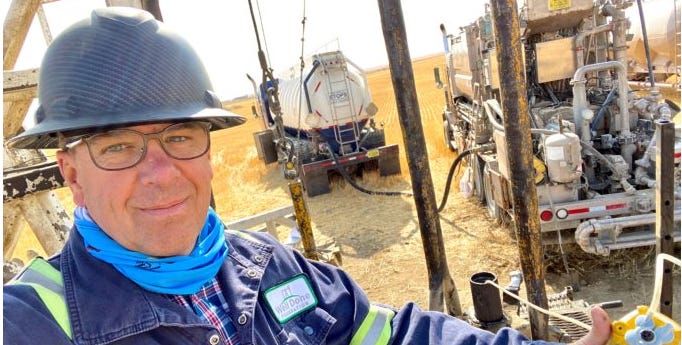Shell and TotalEnergies Profits Slump as Oil and Gas Prices Cool
Shell reported Thursday that it earned nearly $5.1 billion in the second quarter, nearly half what the oil and natural gas giant pulled in during the first three months of the year as energy prices have plunged.
The British energy company said its adjusted earnings followed lower oil and gas prices, production and trading. The figure was down from $11.5 billion in the same period a year ago and $9.6 billion in the first quarter.
Oil and gas prices surged last year after Russia invaded Ukraine, fueling inflation around the world and driving record profits for energy companies, including Shell, British rival BP and others. Prices have since fallen amid weak global economic growth and other factors, leading to lower earnings.
“Shell delivered strong operational performance and cash flows in the second quarter, despite a lower commodity price environment,” CEO Wael Sawan said in a statement.
French group TotalEnergies on Thursday reported a drop in net profit in the second quarter as oil and gas prices have fallen from the highs they reached following Russia's invasion of Ukraine.
Net profit reached $4.1 billion between April and June, down 28 percent from the same period last year, the company said.
"In a favourable but softening oil and gas environment TotalEnergies once again delivered this quarter robust results, strong cash flow, and attractive shareholder distribution," CEO Patrick Pouyanne said in an earnings statement.
Wind Energy Continues to Blow
It’s been a rough-and-tumble summer for offshore wind projects in Rhode Island, as well as for the state’s efforts to reach renewable energy goals.
Both hit a stumbling block last week when Rhode Island Energy announced it was rejecting a joint bid from offshore wind developers Ørsted and Eversource, citing “high proposed contract costs” that were deemed too expensive for the utility company’s customers.
While the utility declined to go into more specifics pending a future filing with the state Public Utilities Commission, it indicated in its announcement that higher interest rates, increased costs of capital, supply chain expenses, and uncertainty over federal tax credits made the project unattractive for the state’s ratepayers.
The joint proposal was also the only bid received by Rhode Island Energy for the offshore wind procurement it issued in October 2022. The original bid, issued at the behest of state officials and lawmakers, sought to solicit between 600 and 1,000 additional megawatts (MW) for the state’s renewable energy portfolio. Avangrid, who owns a controlling interest in most of the other leases just south of Martha’s Vineyard, did not submit a bid.
In a statement, Rhode Island Energy president David Bonenberger said his company was already in talks with state officials to bring more offshore wind to the state.
“We recognize some will be disappointed that we didn’t choose to move forward on negotiating this purchase power agreement,” Bonenberger said. “But that doesn’t mean we’re abandoning our commitment to offshore wind in Rhode Island.”
The rejected bid would have been the second major offshore wind project collaboration between Ørsted and Eversource. Named Revolution Wind 2, the project as proposed would have generated 884 MW of renewable energy, enough to power more than half a million Rhode Island homes, according to the project’s website.
Ørsted and Eversource’s first collaborative project, Revolution Wind, received final approval from regulators at the Coastal Resources Management Council earlier this year, and the federal Bureau of Ocean Energy Management released its final environmental analysis for the project last week. Final federal approval is expected later this year.
That project, expected to become operational in 2025 and provide 400 MW of wind power to Rhode Island, was the beneficiary of a previous RFP for renewable energy issued by previous utility owner National Grid.
Ørsted spokesperson Meaghan Wims said the company was “disappointed” with Rhode Island Energy’s decision and was assessing its options for the Revolution Wind 2 project.
“This project would put Rhode Island’s 100% clean energy future in reach,” said Wims, “delivering renewable energy to hundreds of thousands of homes and creating more than $2 billion in direct economic benefits to the state, with historic investments in local union jobs, workforce training, ports and the supply chain.”
It’s not the first time offshore wind developers in the region have reported higher project costs. In Massachusetts, Commonwealth Wind and SouthCoast Wind indicated in filings to state regulators last fall that their projects may not be as economically viable as they originally thought, and the companies would seek to terminate their already existing power-purchase agreements (PPAs) with utility companies.
The Massachusetts filings led the Rhode Island Public Utilities Commission to order SouthCoast Wind, which at the time was proposing to install an export cable for the project underneath the Sakonnet River and the town of Portsmouth, into a show-cause hearing to explain its reasoning.
At the June 12 hearing, executives from SouthCoast Wind said they decided in May to terminate their contracts, telling regulators that even after paying millions in penalties associated with termination, re-bidding for new contracts next year made more financial sense. The culprit for the project cost increases? Supply chain constraints, inflation, and rising interest rates, according SouthCoast Wind CEO Francis Slingsby.
“The reality for the [offshore wind] industry right now is that almost every developer is seeing that the PPAs and project economics are underwater,” Slingsby told the commissioners at the hearing. “We’re well over 30% cost increase from where we were at executing the PPAs.”
(Commonwealth Magazine reported Avangrid, the developer behind Commonwealth Wind, has agreed to pay $48 million to Massachusetts’ three utility companies to cancel its PPAs. SouthCoast Wind is expected to pay around $60 million to terminate its agreements.)
The increased costs come at a crucial time for the state’s climate goals. Rhode Island has to reduce its greenhouse gas emissions 45% below 1990 levels by 2030, and the new renewable energy standard signed into law last year requires all energy consumed in the state by then to be generated by renewables or offset by credits.
The latest GHG inventory from the state Department of Environmental Management shows the state has reduced its emissions 19.6% below 1990 levels, with electricity consumption accounting for 18.9% of all emissions, the third highest after transportation and home heating emissions.
Despite rapid wind development in recent years, natural gas remains king for electricity generation. According to the latest data available from the Energy Information Administration, natural gas generates 87% of all electricity in Rhode Island.
Renewable energy, including onshore and offshore wind, solar, anaerobic digestion, and hydroelectric, accounts for only 1,000 MW total.
Rhode Island Energy is expected to provide a comprehensive filing explaining its decision to the PUC within the next two months, and Ørsted and Eversource will have a chance to respond.
(article originally published in ECORI)
Indonesia Awards Three Oil and Gas Blocks from First Bidding Round of the Year
Indonesia has awarded three oil and gas blocks with estimated resources of more than 2.4 billion barrels of oil and 9 trillion cubic feet of gas to three companies, its energy ministry said on Thursday.
The three blocks were offered in the first bidding round earlier this year and the winners pledged to a total investment of $22.2 million for the first three years and a $650,000 signature bonus.
On September 18, 2023 The Crude Life will host it’s Fourth Annual Podcast Party at the Energy Exposition being held in Jackson Hole, Wyoming. This year, three energy producing state governors will be joining us.
The Energy Exposition has educated tens of thousands of people in Gillette, Wyoming; Billings, Montana, and Loveland, Colorado, over the last 20 years on procedures, technology, safety, environmental practices, and equipment used in the oil and gas industry.
Exhibitors and Symposiasts represent a wide range of services, including but not limited to, exploration, production, downstream, and all phases of support to the oil and gas industry.
Energy Producing states Alaska Governor Mike Dunleavy, Oklahoma Governor Kevin Stitt and Wyoming Governor Mark Gordon will be attending this year’s expo and kick-off party.
To reserve Exhibit Space contact
Austin Jennings
239-898-3923
austin@energyexposition.com
For discounts and a special gift, use promo code OTIS
The Earth’s Champion Johnny Green (taking pic) is Cleanin’ and Johnny Greenin’ across America engaging with All Walks of Life.
The Greatest Environmentalist on Earth is spreading the word that “Renewables Ain’t Doable Without Fossil Fuelables”.
If you would like The Earth’s Champion Johnny Green and the 15-pounds of Eco-Authority to come to your event, school or town, contact The Crude Life for more info.
“All Energy Has A Purpose, And We Are All Energy,” Johnny Green reminds people of all ages.
Click here to read The Oilman Magazine’s feature on The Earth’s Champion Johnny Green
Click here to read Natural Gas Now’s feature on The Earth’s Champion Johnny Green
The Crude Life Daily Radio News & Lifestyle Update
Curtis Shuck, chairman of the board, Well Done Foundation, talks about methane measuring and the how many orphan wells have been plugged by the Well Done Foundation.
The Crude Life Daily Update has been running as a 3-minute news and lifestyle short on radio stations since 2011. In 2015 online podcast portals and news outlets were added to the list of distributors.
Expert interviews, news updates and multimedia crossovers available upon request.
If you have a news release, energy innovation, story idea, community lifestyle feature, guest, music band or show topic requests, email studio(at)thecrudelife(dot)com
Support the honest hard-working men, women and family who are living The Crude Life today!
About The Crude Life
Award winning interviewer and broadcast journalist Jason Spiess and a team of Content Correspondents engage with the industry’s best thinkers, writers, politicians, business leaders, scientists, entertainers, community leaders, cafe owners and other newsmakers in one-on-one interviews and round table discussions.
The Crude Life has been broadcasting on radio stations since 2011 and posts all updates and interviews on The Crude Life Social Media Network.
Everyday your story is being told by someone. Who is telling your story? Who are you telling your story to?
#thecrudelife promotes a culture of inclusion and respect through interviews, content creation, live events and partnerships that educate, enrich, and empower people to create a positive social environment for all, regardless of age, race, religion, sexual orientation, or physical or intellectual ability.
Spread the word. Support the industry. Share the energy.






















Oil Profits Down, Wind Rates Increasing, India Buying Crude Blocks and Orphan Wells